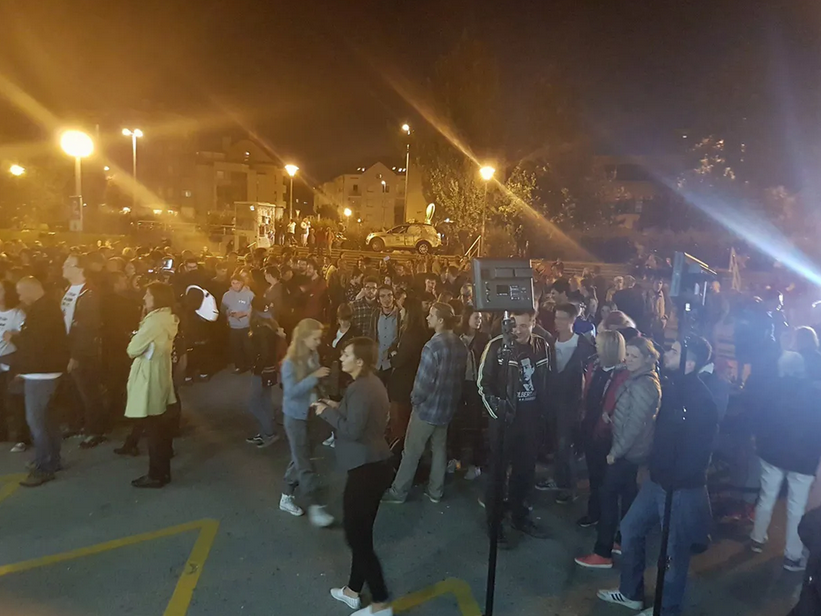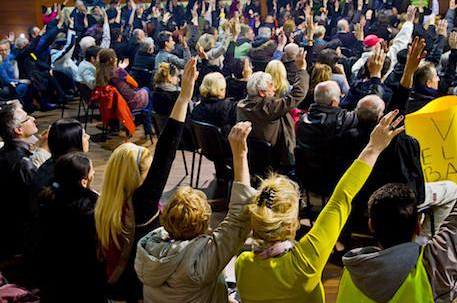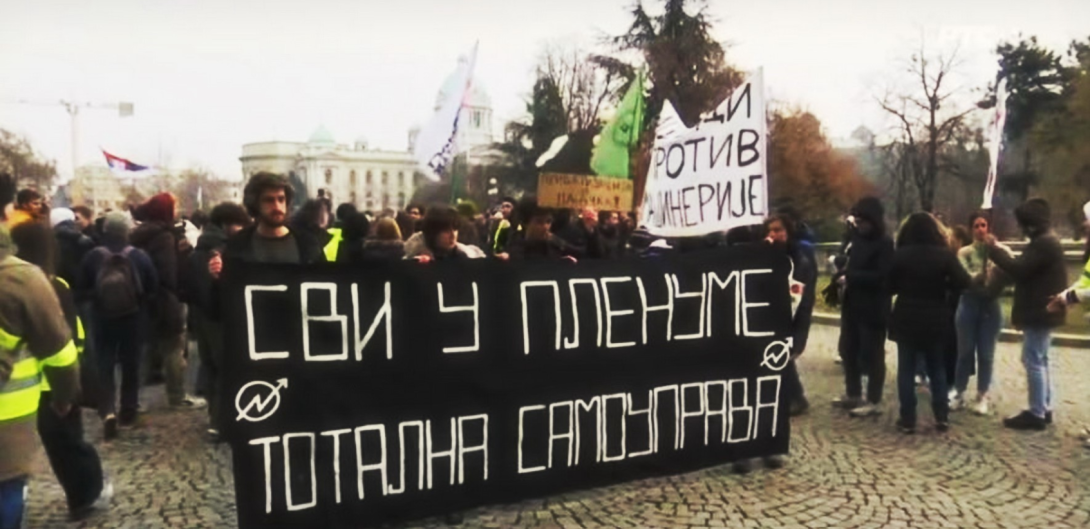
Originally published at Towards Autonomy
Today, plenums are talking about a new type of direct democracy.
~Dalibor Petrović1
We see that in different temporal and spatial realities, in moments of social upheaval, that societies begin to move and self-organize. There is a common trait that often connects such experiences – the emergence of grassroots institutions that allow for direct participation of the citizenry. These reflect what CLR James has termed as universal sentiment towards direct democracy.2 Such democratic institutions emerged during the French Revolution in the form of sectional assemblies3, in the heyday of the Haitian Revolution as organs of the people4, in the early stages of the Russian Revolution as soviets5, throughout the Spanish Revolution in the shape of popular committees6.
Nowadays the institutional expression of this rebellious creativity is carried by social movements around the world when resisting injustice. We witness it also in the Balkans, where a particular grassroots institution persistently makes its appearance at every major upheaval – that of the plenum in the post-Yugoslav space.
The plenum, in the imaginary of social movements in the region, signifies a form of democratic assembly open to popular participation. Journalist Nemanja Rujevic explains that this Latin term essentially means the attendance of the largest possible set of all members.7 For protesters this implies that all decisions concerning them and the general course of society, should be taken by (or at least open to the participation of) the greatest possible majority. In this sense, the plenum indicates a strive towards direct democracy. Social movements in the post-Yugoslav space, because of their shared past and language similarities, keep influencing each other (thus the common vucabulary), transmitting newly emerging democratic significations and perspectives across national borders. Rather than some nostalgia for the old centralized socialist past, the grassroots implementation of the plenum signifies the struggle of the oppressed for autonomy – a struggle that can be observed since ancient times throughout the world.
Its first major appearance was arguably in the 2008-2009 student movement in Croatia that fought for free – publicly financed – higher education. During this period students occupied over 20 universities throughout the country. Abandoning the bodies of student representation, the student movement managed the occupations and its actions through plenums and working groups. But what is even more significant is that students opened their decision-making bodies to the whole of society, thus moving their struggle beyond the educational sphere and toward more generalized opposition to the system as a whole.8 And although with the passage of time the dynamic of the movement faded, it nonetheless (as we will see below), left powerful legacy of direct democracy for the broader region.

In 2014, in Bosnia and Herzegovina, a popular uprising took place. It was provoked by widespread corruption and worsening economic conditions, spearheaded by privatization of factories and sacking of workers en mass. Citizens from all walks of life took to the streets to oppose the ruling class. Burning government buildings in major cities, Bosnians also began setting up plenums of their own, where everyone were able to participate in long deliberations.9 With authorities being unable to suppress with naked force the popular uprising and its democratic content, local municipalities were forced to adopt many of the demands of the multitude, such as the revision of privatizations, the end of excessive politicians’ benefits, various social demands etc.10 And while plenums couldn’t radically alter the political architecture in Bosnia and Herzegovina, they left a lasting mark in the region.

In today’s Serbia a massive social movement has risen against the impunity and greed of the ruling elite. Provoked by the newly-reconstructed railway station canopy collapse in the city of Novi Sad in November 2024, which left 15 people dead and two severely injured, a wave of popular rage is shaking the country. Hundreds of thousands took to the streets, people from all walks of life, with most energetic being the university students. It is exactly the student movement that articulated the institution of the plenum as an alternative to the corruption-breeding system of representation. Organizing their protest activities horizontally, through plenums of their own, students have been calling on all of society to adopt this element of the democratic project as a practice and as a horizon.11 And whatever the outcome of this movement may be, one thing is for sure – it once again brought direct democracy at the forefront of public debate in the Balkans and beyond.

And finally, in the republic of North Macedonia people have risen against the widespread corruption in the country, so typical for oligarchic capitalist systems, that resulted in yet another tragedy – the fire in a night club (with a disputed operating license) in the town of Kočani, which claimed the lives of 59 young people. Being fed up with the powerful and wealthy prioritizing their profits over the lives of people, popular anger filled the streets of cities across North Macedonia. Among the ongoing demonstrations there are already calls on society to self-organize itself on the basis of plenums. Groups have been formed, with names such as “Student Plenum”, while in the capital Skopje assemblies have begun taking place.12 All this shows promising signs that the popular strive towards direct democracy is still alive also in North Macedonia. Indicative is a statement issued by the informal group Promeni.mk, a collective that advocates for independent and non-partisan protests, that rejects political representation and calls instead for popular self-action:
Enough of accepting injustice as a ’normal thing’! Macedonia is sinking into corruption, incompetence and hopelessness, and nobody is doing anything about it. The lack of organized protests is appalling – it’s time for citizens to take responsibility themselves! No more waiting for ’someone else’ to do something. We are the ones who will make a difference.13

All these cases come to show that the universal sentiment towards direct democracy is present and alive among social movements and upheavals throughout the post-Yugoslav. Time and over again protesting multitudes bring to the forefront of public debates the grassroots institution of the plenum as both the means and ends of achieving social justice. The question that remains is whether plenums will be able to sustain a long-term functioning, that surpasses the heyday of social uprisings, and form confederations among each other so that a new organizational model from below can emerge and challenge the status quo. Two things may give us hope that one such perspective is possible: on the one hand, it is the persistency with which the plenum institution is being brought back to the forefront of public debate and practice; the fact that in the city of Maribor, Slovenia – yet another post-Yugoslav country – a grassroots movement has managed to sustain a functioning network of citizen assemblies in around 10 city districts for over 10 years.14 Whatever the future may hold, such developments can only give us hope that another world is possible and inspire us to act in our own geographies.
- 1
Rujević, Nemanja. “The Ćaci Do Not Want a Plenum.” Vreme, March 5, 2025.
- 2
Susan Craig (ed.): Contemporary Carribean: A Sociological Reader (Maracas: The College Press, 1981), 23.
- 3
Albert Soboul: The Sans Culottes: The Popular Movement and Revolutionary Government, 1793–1794 (New York: Doubleday & Co., 1972), 95.
- 4
Sudhir Hazareesingh: Black Spartacus: The Epic Life of Toussaint Louverture (London: Penguin Books, 2021), p147.
- 5
Suzi Weissman: ‘The Russian Revolution and Workers Democracy‘ in Against the Current, No. 188, May/June 2017 [available online at https://www.marxists.org/history/etol/newspape/atc/4975.html%5D
- 6
Gaston Leval: Collectives in the Spanish revolution: Detailed account of worker-controlled agriculture, industry and public services in revolutionary Spain during the civil war. (London: Freedom Press, 1975). [available online at https://theanarchistlibrary.org/library/gaston-leval-collectives-in-the-spanish-revolution#toc22%5D
- 7
Rujević, Nemanja. “The Ćaci Do Not Want a Plenum.” Vreme, March 5, 2025. https://vreme.com/en/vesti/caci-nece-plenum/
- 8
Horvat, Srećko, and Igor Štiks. “The New Balkan Revolts: From Protests to Plenums, and Beyond.” openDemocracy, March 12, 2014. https://www.opendemocracy.net/en/can-europe-make-it/new-balkan-revolts-from-protests-to-plenums-and-beyond/.
- 9
Europe Solidaire Sans Frontières. “Bosnia and Herzegovina: Plenums, Power, Politics.” January 28, 2014. https://www.europe-solidaire.org/spip.php?article32246.
- 10
Horvat, Srećko, and Igor Štiks. “The New Balkan Revolts: From Protests to Plenums, and Beyond.” openDemocracy, March 12, 2014. https://www.opendemocracy.net/en/can-europe-make-it/new-balkan-revolts-from-protests-to-plenums-and-beyond/.
- 11
Mašina. “Students from All Over Serbia on Their Way to Belgrade: ‘Every Corner of the Country Echoes with One Voice’.” LeftEast, March 14, 2025. https://lefteast.org/students-from-all-over-serbia-on-their-way-to-belgrade-every-corner-of-the-country-echoes-with-one-voice/.
- 12
Europe Solidaire Sans Frontières. ” ‘Everyone to the Plenum!’: The Beginning of Self-Organisation in North Macedonia.” Accessed March 23, 2025. https://www.europe-solidaire.org/spip.php?article74112.
- 13
Europe Solidaire Sans Frontières. ” ‘Everyone to the Plenum!’: The Beginning of Self-Organisation in North Macedonia.” Accessed March 23, 2025. https://www.europe-solidaire.org/spip.php?article74112.
- 14
IMZ Maribor (Iniciativa Mestni Zbor) and Alexandria Shaner. “IMZ: 10 Years of Citizens’ Assemblies.” ZNetwork. December 5, 2022. https://znetwork.org/znetarticle/imz-10-years-of-citizens-assemblies/.

Add new comment